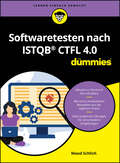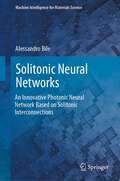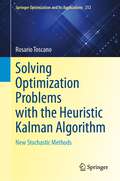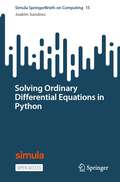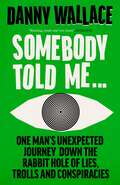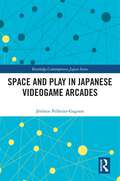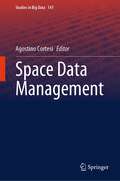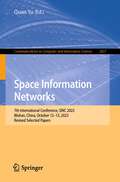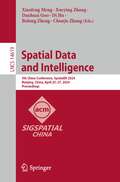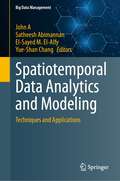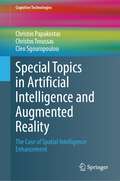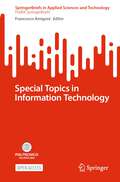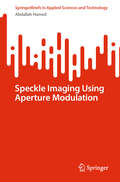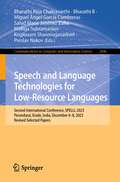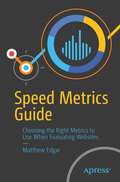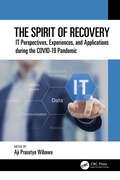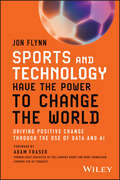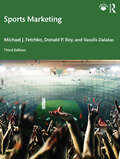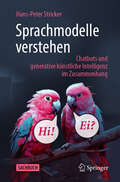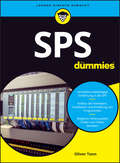- Table View
- List View
Softwaretesten nach ISTQB CTFL 4.0 für Dummies (Für Dummies)
by Maud SchlichNeue Hauptversion 4.0: Neuer Lehrplan, geänderter Prüfungsumfang! Soll in Ihrem Unternehmen neue Software eingeführt werden und Sie müssen sie testen? Oder wollen Sie als Entwickler über den Tellerrand schauen und sich auch mit dem Softwaretesten beschäftigen? Leicht verständlich erläutert Ihnen Maud Schlich alle vom ISTQB® Certified Tester Foundation Level geforderten Lerninhalte sowohl für Programmierer als auch mit Blick auf Fachanwender, die die Software später einsetzen. Zahlreiche praxisorientierte Beispiele und übungen sorgen für eine optimale Prüfungsvorbereitung. Darüber hinaus erfahren Sie für alle Testaktivitäten, wie sie jeweils im klassischen oder im agilen Kontext geplant und durchgeführt werden. Sie erfahren Aus welchen Aktivitäten der Testprozess besteht Wie Sie unterschiedliche Testverfahren nutzen Wie Entwickler und Tester optimal zusammenarbeiten Wie Sie prüfen, ob Sie noch im Plan sind
Solitonic Neural Networks: An Innovative Photonic Neural Network Based on Solitonic Interconnections (Machine Intelligence for Materials Science)
by Alessandro BileThis book delves into optics and photonic materials, describing the development of an intelligent all-optical system capable of replicating the functional building blocks of the biological brain. Starting with an analysis of biological neuronal dynamics and traversing the state of the art of neuromorphic systems developed to date, the book arrives at a description of neural networks realized through spatial soliton technology.After a brief introduction to the biology of neural networks (Chapter 1), the book delves into the description of the neuromorphic problem emphasizing the peculiarities of optical hardware developed to date. (Chapter 2). Chapter 3 is dedicated to the description of psychomemories , which represent the modeling of human learning according to the theories of modern neuro-psychology. This chapter provides the prerequisites for understanding how solitonic neural networks (SNNs) are able to learn and how they approach biological models. Chapter 4 focuses on the experimentation of solitonic optic neurons in thin layers of lithium niobate. Optical techniques for supervised and unsupervised learning are discussed. The entire chapter is accompanied by theoretical, simulative and experimental results. This chapter explains how an X-junction neuron is able to establish synapses, modify them, or erase them. The erasure of solitonic structures represents an important innovation in the field of nonlinear optics. Finally, Chapter 5 reports on the implementation of a network of neurons capable of processing information and storing it exactly as a human episodic memory does. The chapter ends with a number of insights into the lines of research that are currently being pursued on the basis of the results obtained.The book is meant for graduate students and researchers in the fields of optics, photonic applications, and biology. However, the main beneficiaries of this book are senior researchers in the field of nonlinear optics and artificial intelligence. To fully understand the results, it is important to have a basic knowledge of optical physics and neuron biology.
Solutions Architect's Handbook: Kick-start your career with architecture design principles, strategies, and generative AI techniques
by Saurabh Shrivastava Neelanjali SrivastavFrom fundamentals and design patterns to the latest techniques such as generative AI, machine learning and cloud native architecture, gain all you need to be a pro Solutions Architect crafting secure and reliable AWS architecture.Key FeaturesHits all the key areas -Rajesh Sheth, VP, Elastic Block Store, AWSOffers the knowledge you need to succeed in the evolving landscape of tech architecture - Luis Lopez Soria, Senior Specialist Solutions Architect, GoogleA valuable resource for enterprise strategists looking to build resilient applications - Cher Simon, Principal Solutions Architect, AWSBook DescriptionMaster the art of solution architecture and excel as a Solutions Architect with the Solutions Architect's Handbook. Authored by seasoned AWS technology leaders Saurabh Shrivastav and Neelanjali Srivastav, this book goes beyond traditional certification guides, offering in-depth insights and advanced techniques to meet the specific needs and challenges of solutions architects today. This edition introduces exciting new features that keep you at the forefront of this evolving field. Large language models, generative AI, and innovations in deep learning are cutting-edge advancements shaping the future of technology. Topics such as cloud-native architecture, data engineering architecture, cloud optimization, mainframe modernization, and building cost-efficient and secure architectures remain important in today's landscape. This book provides coverage of these emerging and key technologies and walks you through solution architecture design from key principles, providing you with the knowledge you need to succeed as a Solutions Architect. It will also level up your soft skills, providing career-accelerating techniques to help you get ahead. Unlock the potential of cutting-edge technologies, gain practical insights from real-world scenarios, and enhance your solution architecture skills with the Solutions Architect's Handbook.What you will learnExplore various roles of a solutions architect in the enterpriseApply design principles for high-performance, cost-effective solutionsChoose the best strategies to secure your architectures and boost availabilityDevelop a DevOps and CloudOps mindset for collaboration, operational efficiency, and streamlined productionApply machine learning, data engineering, LLMs, and generative AI for improved security and performanceModernize legacy systems into cloud-native architectures with proven real-world strategiesMaster key solutions architect soft skillsWho this book is forThis book is for software developers, system engineers, DevOps engineers, architects, and team leaders who already work in the IT industry and aspire to become solutions architect professionals. Solutions architects who want to expand their skillset or get a better understanding of new technologies will also learn valuable new skills. To get started, you'll need a good understanding of the real-world software development process and some awareness of cloud technology.
Solving Optimization Problems with the Heuristic Kalman Algorithm: New Stochastic Methods (Springer Optimization and Its Applications #212)
by Rosario ToscanoThis text focuses on simple and easy-to-use design strategies for solving complex engineering problems that arise in several fields of engineering design, namely non-convex optimization problems. The main optimization tool used in this book to tackle the problem of nonconvexity is the Heuristic Kalman Algorithm (HKA). The main characteristic of HKA is the use of a stochastic search mechanism to solve a given optimization problem. From a computational point of view, the use of a stochastic search procedure appears essential for dealing with non-convex problems.The topics discussed in this monograph include basic definitions and concepts from the classical optimization theory, the notion of the acceptable solution, machine learning, the concept of preventive maintenance, and more. The Heuristic Kalman Algorithm discussed in this book applies to many fields such as robust structured control, electrical engineering, mechanical engineering, machine learning, reliability, and preference models. This large coverage of practical optimization problems makes this text very useful to those working on and researching systems design. The intended audience includes industrial engineers, postgraduates, and final-year undergraduates in various fields of systems design.
Solving Ordinary Differential Equations in Python (Simula SpringerBriefs on Computing #15)
by Joakim SundnesThis open access volume explains the foundations of modern solvers for ordinary differential equations (ODEs). Formulating and solving ODEs is an essential part of mathematical modeling and computational science, and numerous solvers are available in commercial and open source software. However, no single ODE solver is the best choice for every single problem, and choosing the right solver requires fundamental insight into how the solvers work. This book will provide exactly that insight, to enable students and researchers to select the right solver for any ODE problem of interest, or implement their own solvers if needed. The presentation is compact and accessible, and focuses on the large and widely used class of solvers known as Runge-Kutta methods. Explicit and implicit methods are motivated and explained, as well as methods for error control and automatic time step selection, and all the solvers are implemented as a class hierarchy in Python.
Somebody Told Me: One Man’s Unexpected Journey Down the Rabbit Hole of Lies, Trolls and Conspiracies
by Danny Wallace'Shocking, timely and - as you’d expect from Danny Wallace - very funny' - Adam Kay'Thrilling, thought-provoking, funny and wise. Danny has an incredible knack for taking the bizarre fringes and rabbit holes of humanity and making them compulsively laugh-out-loud readable.' - Danny Robins, journalist, presenter of Uncanny and writer of 2:22 A Ghost Story'Danny Wallace lightens this dark topic about lies and propaganda with his trademark humour and gets the balance just right' – BBC, Books to Read in 2024Have you been keeping your eye on your grandma lately? Have you been calling her enough? You sure she’s not spending too much time on YouTube? Is she talking fondly of dictators? Has she suddenly started quietly muttering in the Aldi queue about the “Jewish Space Lasers” she’s heard are setting wildfires around the world to make sure everyone believes in climate change? When was the moment the world began to believe anything?Danny Wallace, million-copy bestselling author of Yes Man and Join Me, has fallen down the modern rabbit hole of lies, conspiracies and disinformation. Along the way, he encounters families torn apart by accusations and fake news, journalists putting themselves on the frontline of the disinformation war, reformed conspiracy theorists, influencers who see profit in stoking paranoia, and the shadowy nameless, faceless trolls on the other side of our screens. He discovers how disinformation and well-told lies can ruin a year or a whole life, how they can affect our family, our street, our community. How they can spread across a country, a continent, even the world. How they take hold of our imaginations and make us feel both helpless and powerful.And Danny asks: can you do anything to stop it – even with the truth on your side?
Space and Play in Japanese Videogame Arcades (Routledge Contemporary Japan Series)
by Jérémie Pelletier-GagnonThis book presents a scholarly investigation of the development and culture of Japanese videogame arcades, both from a historical and contemporary point of view.Providing an overview of the historical evolution of public amusement spaces from the early rooftop amusement spaces from the early nineteenth century to the modern multi‑floor and interconnected arcade complexes that characterize the urban fabric of contemporary Japan, the book argues that arcade videogames and their associated practices must be examined in the context in which they are played, situated in the interrelation between the game software, the cabinets as material conditions of play, and the space of the venue that frames the experience. Including three case studies of distinct and significant game centres located in Tokyo and Kyoto, the book addresses of play in public, including the notion of performance and observation as play practices, spatial appropriation, as well as the compartmentalization of the play experience.In treating videogames as sets of circumstances, the book identifies the opportunities for ludic practices that videogame arcades provide in Japan. As such, it will appeal to students and scholars of Game Studies and Digital Media Studies, as well as those of Japanese Culture and Society.
Space and Play in Japanese Videogame Arcades (Routledge Contemporary Japan Series)
by Jérémie Pelletier-GagnonThis book presents a scholarly investigation of the development and culture of Japanese videogame arcades, both from a historical and contemporary point of view.Providing an overview of the historical evolution of public amusement spaces from the early rooftop amusement spaces from the early nineteenth century to the modern multi‑floor and interconnected arcade complexes that characterize the urban fabric of contemporary Japan, the book argues that arcade videogames and their associated practices must be examined in the context in which they are played, situated in the interrelation between the game software, the cabinets as material conditions of play, and the space of the venue that frames the experience. Including three case studies of distinct and significant game centres located in Tokyo and Kyoto, the book addresses of play in public, including the notion of performance and observation as play practices, spatial appropriation, as well as the compartmentalization of the play experience.In treating videogames as sets of circumstances, the book identifies the opportunities for ludic practices that videogame arcades provide in Japan. As such, it will appeal to students and scholars of Game Studies and Digital Media Studies, as well as those of Japanese Culture and Society.
Space Data Management (Studies in Big Data #141)
by Agostino CortesiThe book presents latest results pertaining to challenges faced by researchers in space data management. There are large number of highly important applications that currently rely upon data from satellites and space missions, ranging from weather prediction to monitoring of environmental pollution, climate change, marine traffic, agriculture, and urban planning, etc. The quality and quantity of space data poses new and specific challenges to the scientific community, covering the entire life cycle of space data management and with a need for an interdisciplinary approach. The chapters written by experts discusses impacts of these challenges, and report activities that can stimulate new research.
Space Information Networks: 7th International Conference, SINC 2023, Wuhan, China, October 12–13, 2023, Revised Selected Papers (Communications in Computer and Information Science #2057)
by Quan YuThis book constitutes revised selected papers from the thoroughly refereed proceedings of the 7th International Conference on Space Information Network, SINC 2023, held in Wuhan, China, during October 12–13, 2023. The 8 full papers and 5 short papers included in this book were carefully reviewed and selected from 73 submissions. The papers present the latest research in the fields of space information networks.
Spatial Data and Intelligence: 5th China Conference, SpatialDI 2024, Nanjing, China, April 25–27, 2024, Proceedings (Lecture Notes in Computer Science #14619)
by Xiaofeng Meng Xueying Zhang Bolong Zheng Danhuai Guo Di Hu Chunju ZhangThis book constitutes the refereed post proceedings of the 5th China Conference on Spatial Data and Intelligence, SpatialDI 2024, held in Nanjing, China, during April 25–27, 2024. The 25 full papers included in this book were carefully reviewed and selected from 95 submissions. They were organized in topical sections as follows: Spatiotemporal Data Analysis, Spatiotemporal Data Mining, Spatiotemporal Data Prediction, Remote Sensing Data Classification and Applications of Spatiotemporal Data Mining.
Spatiotemporal Data Analytics and Modeling: Techniques and Applications (Big Data Management)
by John A Satheesh Abimannan El-Sayed M. El-Alfy Yue-Shan ChangWith the growing advances in technology and transformation to digital services, the world is becoming more connected and more complex. Huge heterogeneous data are generated at rapid speed from various types of sensors. Augmented with artificial intelligence and machine learning and internet of things, latent relations, and new insights can be captured helping in optimizing plans and resource utilization, improving infrastructure, and enhancing quality of services. A “spatial data management system” is a way to take care of data that has something to do with space. This could include data such as maps, satellite images, and GPS data. A temporal data management system is a system designed to manage data that has a temporal component. This could include data such as weather data, financial data, and social media data. Some advanced techniques used in spatial and temporal data management systems include geospatial indexing for efficient querying and retrieval of location-based data, time-series analysis for understanding and predicting temporal patterns in datasets like weather or financial trends, machine learning algorithms for uncovering hidden patterns and correlations in large and complex datasets, and integration with Internet of Things (IoT) technologies for real-time data collection and analysis. These techniques, augmented with artificial intelligence, enable the extraction of latent relations and insights, thereby optimizing plans, improving infrastructure, and enhancing the quality of services. This book provides essential technical knowledge, best practices, and case studies on the state-of-the-art techniques of artificial intelligence and machine learning for spatiotemporal data analysis and modeling. The book is composed of several chapters written by experts in their fields and focusing on several applications including recommendation systems, big data analytics, supply chains and e-commerce, energy consumption and demand forecasting,and traffic and environmental monitoring. It can be used as academic reference at graduate level or by professionals in science and engineering related fields such as data science and engineering, big data analytics and mining, artificial intelligence, machine learning and deep learning, cloud computing, and internet of things.
Special Topics in Artificial Intelligence and Augmented Reality: The Case of Spatial Intelligence Enhancement (Cognitive Technologies)
by Christos Papakostas Christos Troussas Cleo SgouropoulouThis monograph explores the synergy of Artificial Intelligence (AI), Augmented Reality (AR) and cognitive processes to enhance spatial abilities — an integral aspect of cognitive development. The ability to comprehend and manipulate spatial information is not only fundamental to our understanding of the physical world but also plays a pivotal role in numerous academic and professional fields. Recognizing the profound impact of spatial ability on scientific disciplines and educational achievement, this monograph takes on the challenge of enhancing spatial skills among users.The authors present the design and development of a mobile training system that incorporates AR features to enhance learners’ spatial ability. Involving mental generation, transformation, and rotation of visual images for understanding spatial relationships, spatial ability is closely linked to success in various scientific disciplines and educational pursuits. While spatial visualization skills tests are available, this monograph takes a unique approach by focusing on developing targeted interventions to improve spatial ability. It aims to unlock new avenues for cognitive growth and dive into the untapped potential within the realm of spatial intelligence. Beyond its emphasis on spatial ability enhancement, this monograph goes above and beyond traditional approaches by integrating AI techniques into the training system. As such, it aims to provide personalized and adaptive learning experiences for learners. The training system, through intelligent techniques, dynamically analyzes individual learners’ strengths, weaknesses, and progress, tailoring content and challenges to their specific needs. This effort establishes a new frontier in educational technology, offering a groundbreaking solution that not only augments spatial ability development but also showcases the transformative potential of AI in reshaping the learning experience.The book is a valuable resource for researchers, educators, developers and technology enthusiasts, as it exemplifies the profound impact of AI and AR in shaping the future of online learning experiences.
Special Topics in Information Technology (SpringerBriefs in Applied Sciences and Technology)
by Francesco AmigoniThis open access book presents outstanding doctoral dissertations in Information Technology from the Department of Electronics, Information and Bioengineering, Politecnico di Milano, Italy. Information Technology has always been highly interdisciplinary, as many aspects have to be considered in IT systems. The doctoral studies program in IT at Politecnico di Milano emphasizes this interdisciplinary nature, which is becoming more and more important in recent technological advances, in collaborative projects, and in the education of young researchers. Accordingly, the focus of advanced research is on pursuing a rigorous approach to specific research topics starting from a broad background in various areas of Information Technology, especially Computer Science and Engineering, Electronics, Systems and Control, and Telecommunications. Each year, more than 50 Ph.D.s. graduate from the program. This book gathers the outcomes of the best theses defended in 2022–23 and selected for the IT Ph.D. Award. Each of the authors provides a chapter summarizing his/her findings, including an introduction, description of methods, main achievements and future work on the topic. Hence, the book provides a cutting-edge overview of the latest research trends in Information Technology at Politecnico di Milano, presented in an easy-to-read format that will also appeal to non-specialists.
Speckle Imaging Using Aperture Modulation (SpringerBriefs in Applied Sciences and Technology)
by Abdallah HamedThis book covers speckle image formation using a variety of modulated apertures. The central theme revolves around theoretical analyses, specifically the calculation of impulse responses or Point Spread Functions (PSFs) corresponding to these apertures. These calculations provide crucial insights into the resolution inherent in the resulting speckle images. The book begins with an examination of the recognition of the direction of new apertures from elongated speckle images, setting the stage for subsequent discussions. The theoretical analyses extend to diverse aperture designs, including Gaussian, graded-index, and modulated apertures. The book delves into the nuanced dynamics of contrast in speckle images, exploring the Voigt distribution and the effects of modulation on contrast. In addition to aperture-centric discussions, the book addresses the processing of the formed speckle images. The chapters impart a comprehensive understanding of speckle imaging, encompassing discrimination in microscopy using digital speckle images, the utilization of concentric hexagonal pupils, and the exploration of irregular apertures. The book culminates in a detailed exploration of speckle imaging in the context of an annular Hermite Gaussian laser beam. Overall, this book serves as a valuable resource for researchers and academics seeking a profound exploration of speckle image formation, modulation, and processing across a spectrum of apertures and theoretical frameworks.
Speech and Language Technologies for Low-Resource Languages: Second International Conference, SPELLL 2023, Perundurai, Erode, India, December 6–8, 2023, Revised Selected Papers (Communications in Computer and Information Science #2046)
by Bharathi Raja Chakravarthi Bharathi B Miguel Ángel García Cumbreras Salud María Jiménez Zafra Malliga Subramanian Kogilavani Shanmugavadivel Preslav NakovThis book constitutes the refereed conference proceedings of the second International Conference on Speech and Language Technologies for Low-Resource Languages, SPELLL 2023, held in Perundurai, Erode, India, during December 6–8, 2023. The 27 full papers and 6 short papers presented in this book were carefully reviewed and selected from 94 submissions. The papers are divided into the following topical sections: language resources; language technologies; speech technologies; and workshops - regional fake, MMLOW, LC4.
Speed Metrics Guide: Choosing the Right Metrics to Use When Evaluating Websites
by Matthew EdgarFaster websites offer a better user experience and typically have higher conversion rates. It can be challenging to know where to invest to meaningfully improve a website's speed. Investing correctly to improve speed starts with understanding how to correctly measure speed and knowing how to use those measurements to identify the biggest opportunities. Speed Metrics Guide helps marketers, SEOs, business leaders, designers, and everybody else involved in website performance select the right metrics to use to optimize their website's speed. Each chapter examines a specific metric, discusses what it measures, why the metric matters and what tactics will help improve that metric. What You'll LearnThe best metrics and tools to help you measure website speed, including Google's Core Web VitalsHow and when to best use each metricWhere each metric fits within the website loading processHow to use each metric to find different ways of improving website speed Who This book Is ForNon-technical audience, including marketers, SEOs, designers, and UX professionals.
The Spirit of Recovery: IT Perspectives, Experiences, and Applications during the COVID-19 Pandemic
by Aji Prasetya WibawaThe scope of this book focuses on how information technology may assist in achieving goals and in providing solutions to problems such as a pandemic. Research on the Internet and on technology has been done, and the findings have applications in various sectors that rely on interdisciplinary knowledge. This book explores and describes state-of-the-art research conducted during the COVID-19 pandemic. Topics covered include the IT viewpoint and the rules governing digital transformation throughout the pandemic. The Digital Revolution sped up by a decade during COVID-19, which impacted both the user experience and that of software developers. As a component of the digital transformation process, this book explores the experiences of both the user and developer when attempting to change and adapt while utilizing an information technology program. This book includes five topics: (1) multidisciplinary artificial intelligence, (2) Smart City and Internet of Things applications, (3) game technology and multimedia applications, (4) data science and business intelligence, and (5) IT hospitality and information systems. Each topic is covered in several book chapters with some application in several countries, especially developing countries. The chapters provide insight from contributors with different perspectives and several diverse fields who present new ideas and approaches to solving problems associated with the worldwide pandemic.
The Spirit of Recovery: IT Perspectives, Experiences, and Applications during the COVID-19 Pandemic
by Aji Prasetya WibawaThe scope of this book focuses on how information technology may assist in achieving goals and in providing solutions to problems such as a pandemic. Research on the Internet and on technology has been done, and the findings have applications in various sectors that rely on interdisciplinary knowledge. This book explores and describes state-of-the-art research conducted during the COVID-19 pandemic. Topics covered include the IT viewpoint and the rules governing digital transformation throughout the pandemic. The Digital Revolution sped up by a decade during COVID-19, which impacted both the user experience and that of software developers. As a component of the digital transformation process, this book explores the experiences of both the user and developer when attempting to change and adapt while utilizing an information technology program. This book includes five topics: (1) multidisciplinary artificial intelligence, (2) Smart City and Internet of Things applications, (3) game technology and multimedia applications, (4) data science and business intelligence, and (5) IT hospitality and information systems. Each topic is covered in several book chapters with some application in several countries, especially developing countries. The chapters provide insight from contributors with different perspectives and several diverse fields who present new ideas and approaches to solving problems associated with the worldwide pandemic.
Sports and Technology Have the Power to Change the World: Driving Positive Change Through the Use of Data and AI
by Jon FlynnDiscover how the explosions in data analytics, AI, and digital communication are benefiting sports and sports fans around the world In Sports and Technology Have The Power To Change The World: Driving Positive Change Through The Use of Data and AI, the Director of Microsoft Sports, Jon Flynn, delivers an insightful new take on the transformative power of sport and its ability to unite people, break down barriers, and generate positive change. The author explains the critical role that technology has played in growing the impact of sporting events and enabling social change while fostering community improvement. In the book, you’ll explore many of the ways in which sports, enabled by new tech, have made significant contributions to society and promoted individual development, health, and wellbeing. You’ll also find: Discussions of green technologies and climate and sustainability initiatives linked to sport, with a case study about the 2022 Beijing Winter Olympics Explorations of the impact of advanced data analytics, with a case study focusing on the 2013 NBA Final matchup between the Miami Heat and the San Antonio Spurs How sport scientists are optimizing player performance Perfect for anyone interested in the intersection of sport, society, and technology, Sports and Technology Have The Power To Change The World is an easy to read and endlessly fascinating look at how the unique combination of athletics and tech makes the world a better place.
Sports and Technology Have the Power to Change the World: Driving Positive Change Through the Use of Data and AI
by Jon FlynnDiscover how the explosions in data analytics, AI, and digital communication are benefiting sports and sports fans around the world In Sports and Technology Have The Power To Change The World: Driving Positive Change Through The Use of Data and AI, the Director of Microsoft Sports, Jon Flynn, delivers an insightful new take on the transformative power of sport and its ability to unite people, break down barriers, and generate positive change. The author explains the critical role that technology has played in growing the impact of sporting events and enabling social change while fostering community improvement. In the book, you’ll explore many of the ways in which sports, enabled by new tech, have made significant contributions to society and promoted individual development, health, and wellbeing. You’ll also find: Discussions of green technologies and climate and sustainability initiatives linked to sport, with a case study about the 2022 Beijing Winter Olympics Explorations of the impact of advanced data analytics, with a case study focusing on the 2013 NBA Final matchup between the Miami Heat and the San Antonio Spurs How sport scientists are optimizing player performance Perfect for anyone interested in the intersection of sport, society, and technology, Sports and Technology Have The Power To Change The World is an easy to read and endlessly fascinating look at how the unique combination of athletics and tech makes the world a better place.
Sports Marketing
by Michael J. Fetchko Donald P. Roy Vassilis DalakasHighly practical and engaging, Sports Marketing equips students with the skills, techniques, and tools they need to be successful marketers in any sporting environment. The book blends relevant marketing theory—focusing on industry-specific terminology and practices—with practitioner insights into current issues and future directions in the sports industry. This anticipated third edition has been fully updated to incorporate a broad range of global and diverse perspectives from industry experts and international case studies throughout. Contemporary topics within the sports industry have been expanded upon, including esports, social responsibility, sustainability, digital and social media, and personal branding. Popular "You Make the Call" cases, insider and early career insights, and review questions stimulate lively classroom discussion, while chapter summaries and terms support further support learning. Overall, this exciting text will: • Increase students’ depth of knowledge about sports marketing • Challenge students to apply concepts to real-world situations • Profile best practices of organizations and individuals within the sports industry as they relate to the book’s content • Equip students to position themselves to compete for entry-level positions in sports business • Provide faculty with a concise but thorough text that meets their needs. Sports Marketing remains a core textbook for undergraduate and postgraduate students of sports marketing and management, providing a firm grasp of the ins and outs of working in sports. Additional online resources include PowerPoint slides for each chapter, a test bank of questions, and an instructor’s manual.
Sports Marketing
by Michael J. Fetchko Donald P. Roy Vassilis DalakasHighly practical and engaging, Sports Marketing equips students with the skills, techniques, and tools they need to be successful marketers in any sporting environment. The book blends relevant marketing theory—focusing on industry-specific terminology and practices—with practitioner insights into current issues and future directions in the sports industry. This anticipated third edition has been fully updated to incorporate a broad range of global and diverse perspectives from industry experts and international case studies throughout. Contemporary topics within the sports industry have been expanded upon, including esports, social responsibility, sustainability, digital and social media, and personal branding. Popular "You Make the Call" cases, insider and early career insights, and review questions stimulate lively classroom discussion, while chapter summaries and terms support further support learning. Overall, this exciting text will: • Increase students’ depth of knowledge about sports marketing • Challenge students to apply concepts to real-world situations • Profile best practices of organizations and individuals within the sports industry as they relate to the book’s content • Equip students to position themselves to compete for entry-level positions in sports business • Provide faculty with a concise but thorough text that meets their needs. Sports Marketing remains a core textbook for undergraduate and postgraduate students of sports marketing and management, providing a firm grasp of the ins and outs of working in sports. Additional online resources include PowerPoint slides for each chapter, a test bank of questions, and an instructor’s manual.
Sprachmodelle verstehen: Chatbots und generative künstliche Intelligenz im Zusammenhang
by Hans-Peter StrickerDieses Buch befasst sich mit Fragen rund um Sprachmodelle wie ChatGPT und um das Verstehen: Verstehen Chatbots, was wir ihnen sagen und meinen? Wie können uns Chatbots helfen, etwas besser zu verstehen - einen Text oder ein Konzept? Verstehen Sprachmodelle sich selbst - was sie sagen und warum sie es sagen?Können wir Sprachmodelle verstehen und wie?Das Buch richtet sich an technisch und philosophisch interessierte Laien, aber auch an Didaktiker aller Couleur, von der Lehrkraft bis zu Wissenschaftsjournalist:innen.
SPS für Dummies (Für Dummies)
by Oliver TonnSPS ohne Stress Wenn Sie Maschinen oder Anlagen mithilfe einer SPS auch ohne Vorkenntnisse steuern möchten, dann ist dieses Buch für Sie gemacht. Ob Aufbau der Hardware, Installation und Verdrahtung oder Erstellung von Programmen: Jederzeit leicht verständlich erläutert Ihnen Oliver Tonn Grundlagen und fortgeschrittene Techniken der SPS-Programmierung. Dabei lernen Sie SPS sowohl herstellerunabhängig kennen als auch Besonderheiten der verschiedenen Hersteller. Mit zahlreichen Praxisbeispielen vertiefen Sie Ihr Wissen und wenden es schon bald in komplexeren Szenarien erfolgreich an. Sie erfahren Wie Sie ein SPS-Projekt und -Programm erstellen Wie Sie einen Antrieb steuern Wie Sie mit TwinCAT 3 und TIA visualisieren Wie Sie Fehler vermeiden und beheben
